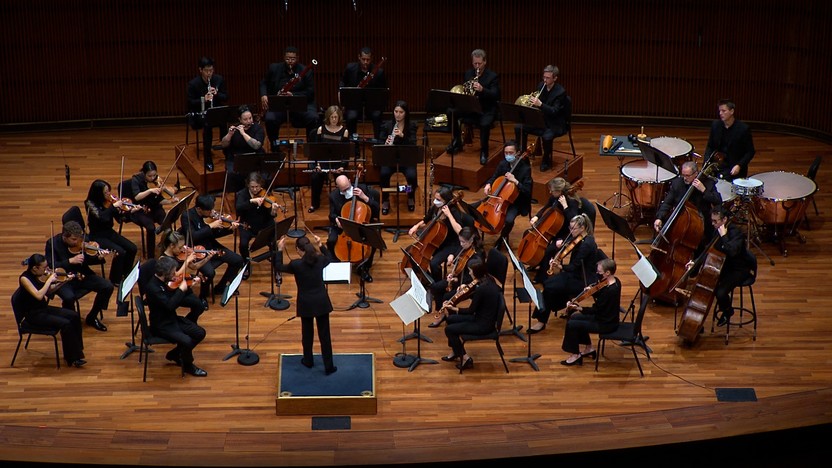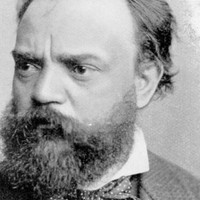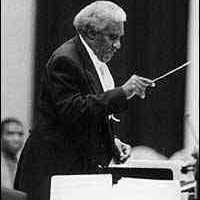Living Traditions


 Watch Video
Watch Video
Czech composer Antonín Dvořák’s Serenade for Winds has remained popular since its 1878 premiere, which was conducted by the composer himself in Prague. Dvořák dedicated the piece to Louis Ehlert, a music critic whose praise for Dvořák’s earlier works had made the composer famous throughout Germany. Like many of Dvořák’s compositions, the Serenade blends sonic elements of classical music with Eastern European folk traditions.
The Serenade opens with a movement that hearkens back to the soundscapes of long-ago court performances from the Rococo period; the sounds of the aristocracy are merged with a song of the common people. This opening theme is particularly important, because it will return near the end of the final movement, thereby making the Serenade a cyclical work. The second movement begins with a wistful, charming minuet. This is followed by a lively trio with syncopated Czech dance rhythms.
Long, sensuous melodies in the slower third movement convey a sense of melancholic nostalgia. The expressive oboe and clarinet are accompanied by subtle syncopation in the horn section and an active bass line. The Serenade ends with a driving, witty Finale reminiscent of the village band. High-level performance on wind instruments was a centuries-long Bohemian tradition, and Dvořák’s Serenade pays tribute to that rich heritage.
The year after the Serenade’s premiere, Johannes Brahms sent a letter to Joseph Joachim praising the work. Brahms wrote: “A more lovely, refreshing impression of real, rich and charming creative talent you can’t easily have…I think it must be a pleasure for the wind players!”
Paula Maust ©2022
 Watch Video
Watch Video
American composer Coleridge-Taylor Perkinson earned B.M. and M.M. degrees in composition from the Manhattan School of Music in the 1950s, a time of great division in American classical music. Proponents of extreme experimentalism dismissed the tastes of the general public and endeavored to keep classical music composition strictly within the academy. Provocative essays such as Milton Babbitt’s “Who cares if you listen?” circulated at the same time that traditional works by composers such as Ludwig van Beethoven were becoming further cemented into a classical music canon aimed at pleasing the public.
Named after the influential Black British composer Samuel Coleridge-Taylor (1875–1912), Perkinson enjoyed a multi-faceted musical career that expanded far beyond these conflicting viewpoints about the function of classical music. When asked to define Black music in an interview for the 1978 book The Black Composer Speaks, for example, Perkinson said: “I cannot define Black music. I could say that it is a music that has its genesis in the Black psyche or the Black social life, but it is very difficult to say what Black music really is. There are kinds of Black music, just as there are kinds of other musics.” Indeed, his rich musical career encompassed a vast array of classical, jazz, dance, pop, film, and television music.
In 1954, when he was just twenty-two years old, Perkinson composed Sinfonietta No. 1. Premiered in 1966, the work is a unique fusion of influences from baroque counterpoint, classical forms, American romantic harmonies, blues, and spirituals. The opening Sonata Allegro movement mixes elements of sonata form, the most common first-movement form in the Classical and Romantic periods. The movement also contains imitative counterpoint in the style of Johann Sebastian Bach.
The Largo “Song Form” is the second of three movements and features carefully controlled dissonances and soaring lyrical melodies. Ambiguous meters, a disrupted rhythmic flow, and a driving pulse are the defining characteristics of the third movement. This movement is written in the Classical rondo form, in which the opening section of music is consistently repeated between contrasting themes.
Paula Maust ©2022
 Watch Video
Watch Video
As we approach his centenary, Louis Ballard is very much alive in spirit. An artist and Indigenous intellect, he is remembered for bringing a dynamic to both social change as well as joining ancient and ultramodern musical traditions. In 1974, a year following the 71- day protest occupation on the Pine Ridge Reservation, Ballard was asked to consider the generational impact of Wounded Knee in two separate centuries in a commission by the SPCO and Dennis Russell Davies. The world premiere brought focus to an event that had captured world media attention and had brought the US government to the negotiating table to review the state of 371 broken treaties with Native American peoples, all of which were fresh in the public’s memory.
On December 29, 1890, nearly 300 Lakota men, women and children were massacred by US Army forces in an encampment at Čhaŋkpé Ópi Wakpála, Wounded Knee Creek. Settlers who had recently become aware of the spiritual ceremony known as the Ghost Dance believed that it portended war, and demanded the Army disarm the Lakota people. The result was an act of genocide, and the village of Wounded Knee would become the symbolic location 83 years later for a reckoning and the longest civil disorder in the history of the U.S. Marshals Service, sometimes referred to as the Second Wounded Knee. Minnesota is the birthplace of the American Indian Movement, a major force in the events recalled by this music.
The opening measures of Incident at Wounded Knee are a reminder that this isn’t a programmatic relic of 19th-century music or a romanticized reinterpretation of Native cultures. Ballard made clear that his was an expression of interior realization, rather than an exterior description of events as they unfolded. Incident at Wounded Knee reflects the positive vision of change that Ballard subscribed to and believed in fiercely and finely. Ballard was a student of composers Darius Milhaud and Mario Castelnuovo-Tedesco, and an admirer of Béla Bartók’s ethnomusicology, and his mastery, mindfulness and creativity continue to live through the SPCO for us and our children and as an enduring tribute to Minnesota’s upholding of history.
Richard LaFortune ©2022
 Watch Video
Watch Video
Recognized for her creative works that seamlessly merge the arts with issues of social justice, mass migration, and multiculturality, Mexican composer Gabriela Ortiz’s music is performed by prestigious ensembles around the world. She writes: “I fell in love with music once I understood that sounds have souls, and it is through them that one may speak of oneself.”
Today’s program features “La Calaca,” the fourth part of Altar de Muertos, which was written in 1997 for the Kronos Quartet and dedicated to the memory of those close to them. The work was inspired by the variety of traditions that shape the Mexican Day of the Dead festival. In particular, the musical ideas in Altar de Muertos portray elements of both reality and magic.
A calaca is a figurine of a human skeleton wearing colorful clothing, which is often decorated with marigold flowers. The first known origins of the calacas can be traced back to Mayan imagery. In most visual depictions, the calacas are shown dancing and playing musical instruments to celebrate a joyous afterlife.
“La Calaca” is full of exuberant, driving rhythmic vitality and haunting melodies. At the end of the movement, Ortiz quotes a spirited melody of Huichol origin from the State of Nayarit, Mexico. This melody was sung by the De La Cruz family, who preserve traditional Huichol music and culture. The second violin plays the first statement of the animated tune, and it is then passed on to the other instruments, culminating in a spirited ending to the piece.
Paula Maust ©2022
Friday and Saturday | 7:00pm | Pre-concert recital by Bryan Akipa and an exhibit curated by All My Relations Arts Gallery and Two Rivers Gallery - Minneapolis American Indian Center
Get driving directions and find nearby parking.
Find dining options close to the venue.
View seating charts to find out where you'll be seating.
Get driving directions and find nearby parking.
Find dining options close to the venue.
View seating charts to find out where you'll be seating.
